SpaceX Makes History with Dragon Splashdown

Introduction
SpaceX's Dragon spacecraft has made history once again by carrying the Ax-4 crew and successfully docking with the International Space Station. But the journey is not over yet - the spacecraft is set to make a splashdown off the coast of San Diego at 2:31 a.m. PT on Tuesday. And with it, a sonic boom is expected to be heard as it re-enters Earth's atmosphere. This exciting event will mark the first time a crewed spacecraft has splashed down off the California coast since 1969.
The Importance of Splashdown
Splashdowns are a crucial part of the space mission, as they allow the spacecraft to safely return its crew and experiments back to Earth. This particular splashdown off the coast of San Diego is ideal due to its proximity to NASA's Johnson Space Center in Houston, where the returning crew will undergo medical check-ups and debrief
About the People Mentioned
Ax-4
Axiom Mission 4 (Ax-4) is a private crewed mission to the International Space Station (ISS) operated by Axiom Space in partnership with SpaceX and NASA, marking a significant milestone in the commercialization of low-Earth orbit[2]. The mission launched on June 25, 2025, aboard SpaceX's Crew Dragon 'Grace' spacecraft—the fifth and final Dragon capsule—and completed an 18-day stay on the ISS before splashing down in the Pacific Ocean on July 15, 2025[1][2]. Ax-4 was notable for both its international crew and its extensive scientific agenda, reflecting the growing global interest in space-based research. The Ax-4 crew was commanded by Peggy Whitson, a former NASA astronaut and current Axiom Space Director of Human Spaceflight, who extended her record to 695 cumulative days in space over five missions, the most by any American astronaut[1][5]. The team included Pilot Shubhanshu Shukla of India, and Mission Specialists Sławosz Uznański-Wiśniewski of Poland and Tibor Kapu of Hungary[4][5]. This mission represented the return of government-sponsored human spaceflight for India, Poland, and Hungary after more than 40 years, and was the first time all three nations sent astronauts to the ISS[3]. For India, this was only the second national astronaut mission since 1984, underscoring the historic nature of the flight[3]. Ax-4 set a new benchmark for private astronaut missions by conducting the most research ever undertaken on an Axiom Space mission, with over 60 scientific activities representing 31 countries[1][4]. The research portfolio spanned technology demonstrations, life sciences, human research, material science, physical and Earth sciences, and STEAM outreach[1][4]. The mission logged 288 orbits and traveled approximately 7.6 million miles during its 18-day ISS stay, contributing 432 hours of research time[1]. This level of scientific productivity signals the increasing capability of commercial missions to support high-impact, international research in low-Earth orbit[1][4]. The mission’s complexity, international collaboration, and record-breaking research output highlight Axiom Space’s role in redefining access to space and elevating national space programs worldwide[3][7]. Ax-4’s success demonstrates the viability of commercial platforms for advancing global scientific discovery and paves the way for future private and international missions to the ISS and beyond[1][3].
About the Organizations Mentioned
SpaceX
SpaceX is a private aerospace manufacturer and space transportation company founded in 2002 by Elon Musk with the mission to revolutionize space technology and enable human life to become multiplanetary[3]. It designs, manufactures, and launches advanced rockets and spacecraft, pioneering reusable rocket technology to dramatically reduce the cost of access to space. One of SpaceX’s key achievements includes the development and operational success of the Falcon 9 and Falcon Heavy rockets, both featuring reusable first-stage boosters. This reusability has significantly lowered launch costs and increased reliability, enabling frequent commercial, scientific, and government missions. SpaceX has launched over 95 national security missions with these rockets, demonstrating maturity and trust from the U.S. Space Force and other agencies[2]. Another major milestone is the Starlink satellite constellation, with nearly 6,900 satellites currently in orbit as of 2025. Starlink aims to provide global broadband internet service, especially in underserved regions, making it one of the largest satellite constellations in history[1]. This ambitious project also serves as a revenue stream to fund SpaceX’s broader goals. Looking ahead, SpaceX is developing Starship, a next-generation fully and rapidly reusable super heavy-lift launch system designed to carry large payloads and humans to the Moon, Mars, and beyond. Elon Musk envisions Starship enabling mass transport to Mars, with the potential to launch multiple times a day, dramatically increasing total mass sent to orbit annually, far surpassing all previous space launch capabilities combined[1][2]. Pending environmental reviews, Starship’s first launch from Florida’s LC-39A is planned for late 2025[2]. Despite these advances, SpaceX remains privately held, with limited public insight into its financial health. Questions persist around the profitability of Falcon launches, Starlink operations, and future Starship missions, especially given the enormous funding required for Mars colonization[1]. Nonetheless, SpaceX continues to inspire both enthusiasm and debate in the business and technology
International Space Station
The **International Space Station (ISS)** is a modular space laboratory and orbital outpost operating in low Earth orbit since 2000, serving as a unique platform for scientific research, technology development, and international cooperation in space. It was designed between 1984 and 1993 and constructed through a partnership among NASA (USA), Roscosmos (Russia), ESA (Europe), JAXA (Japan), and CSA (Canada), with contributions from multiple countries and commercial partners[2][3]. The ISS functions as a laboratory, observatory, and factory in microgravity, enabling experiments across biology, physics, materials science, and Earth observation that are impossible on Earth. It also acts as a staging base for future deep-space missions to the Moon, Mars, and asteroids. Over 290 individuals from 26 countries have visited the station by 2025, reflecting its role as a hub for international collaboration[2]. Key achievements include continuous human presence in orbit for over 25 years (celebrated in 2025), advancements in medical research such as gene therapies for macular degeneration, and studies of muscle aging using tissue chips in microgravity. The ISS supports innovative commercial activities, including partnerships with private companies like SpaceX and Axiom Space for crew transport and module additions. Recent Russian modules like *Nauka* and *Prichal* have expanded the station’s capabilities, supported by robotic systems such as the European Robotic Arm[1][2][4][5]. Currently, the ISS operates with a crew executing expeditions and spacewalks, conducting experiments like the NICER X-ray telescope, and supporting commercial and educational missions. The station’s modular design allows for adaptability, with 43 modules installed as of mid-2025. NASA’s ongoing plans emphasize expanding scientific output, growing the low Earth orbit economy, and maintaining the ISS as a testbed for future exploration[1][2][3]. Notably, the ISS also fosters public engagement throug
NASA
The National Aeronautics and Space Administration (NASA) is the United States’ premier civil space agency, responsible for the nation’s civilian space program, aeronautics research, and aerospace technology development[1][2]. Headquartered in Washington, D.C., NASA operates ten major field centers across the country and employs nearly 18,000 civil servants, supported by an extensive network of contractors, academic institutions, and international partners[1][2]. Since its establishment in 1958, NASA has revolutionized humanity’s understanding of the cosmos, pioneered technological advancements, and shaped global space policy. ## History and Key Achievements NASA was created in response to the Soviet Union’s 1957 launch of Sputnik, with the goal of ensuring U.S. leadership in space exploration. It succeeded the National Advisory Committee for Aeronautics (NACA) and quickly became the driving force behind iconic programs such as Project Mercury (America’s first human spaceflight program), Project Gemini (which developed techniques for space rendezvous and extravehicular activity), and the Apollo program, which landed astronauts on the Moon between 1969 and 1972[1]. The agency also developed the Space Shuttle, the world’s first reusable spacecraft, and built the International Space Station (ISS), a symbol of international collaboration and scientific research[1][5]. NASA’s robotic exploration has been equally transformative, with over 1,000 uncrewed missions investigating Earth, the Moon, Mars, and beyond. The agency’s fleet of observatories—including the Hubble Space Telescope and the James Webb Space Telescope—has provided unprecedented views of the universe, from the birth of stars to the detection of exoplanets[1]. The Perseverance rover is currently searching for signs of ancient life on Mars, while New Horizons explored Pluto and the outer solar system[1]. ## Current Status and Notable Aspects Today, NASA is advancing the Artemis program, aiming to return human
Johnson Space Center
The Johnson Space Center (JSC) in Houston, Texas, is NASA’s premier hub for human space exploration and a cornerstone of American technological innovation. Established on November 1, 1961, as the Manned Spacecraft Center, JSC was rechristened in 1973 to honor President Lyndon B. Johnson, a key advocate for the U.S. space program. Located in the Clear Lake area, JSC was strategically chosen for its proximity to water transport, a major airport, robust telecommunications, and a vibrant academic and industrial ecosystem. JSC is best known as the home of Mission Control, the operational nerve center for every American human spaceflight, from the Gemini and Apollo missions to the Space Shuttle and the International Space Station (ISS). It played a pivotal role in achieving President Kennedy’s goal of landing humans on the Moon, with the iconic words “Houston, the Eagle has landed” echoing from the lunar surface in 1969. The center also led the design, development, and operation of spacecraft, astronaut training, and scientific research, including the quarantine and study of lunar samples after Apollo missions. Today, JSC remains at the forefront of space exploration, directing ISS operations, supporting commercial spaceflight partnerships, and advancing research for future missions to the Moon and Mars. With over 12,000 employees, JSC fosters collaboration with industry, academia, and global partners, driving technological breakthroughs and economic growth. Its legacy is celebrated at Space Center Houston, the official visitor center, which showcases historic spacecraft and offers immersive experiences. JSC’s enduring impact on science, technology, and business continues to inspire innovation and shape the future of space exploration.









